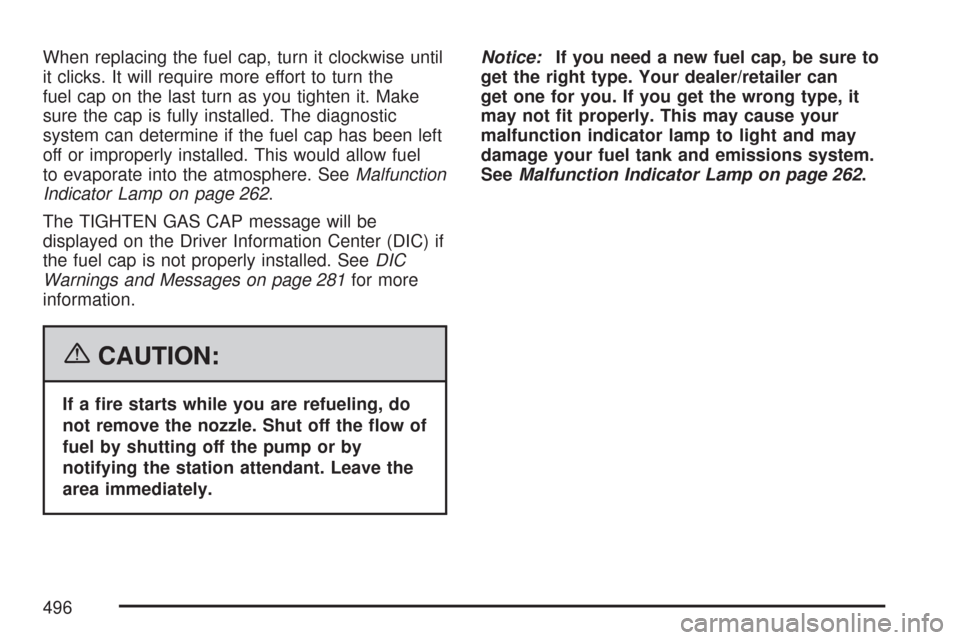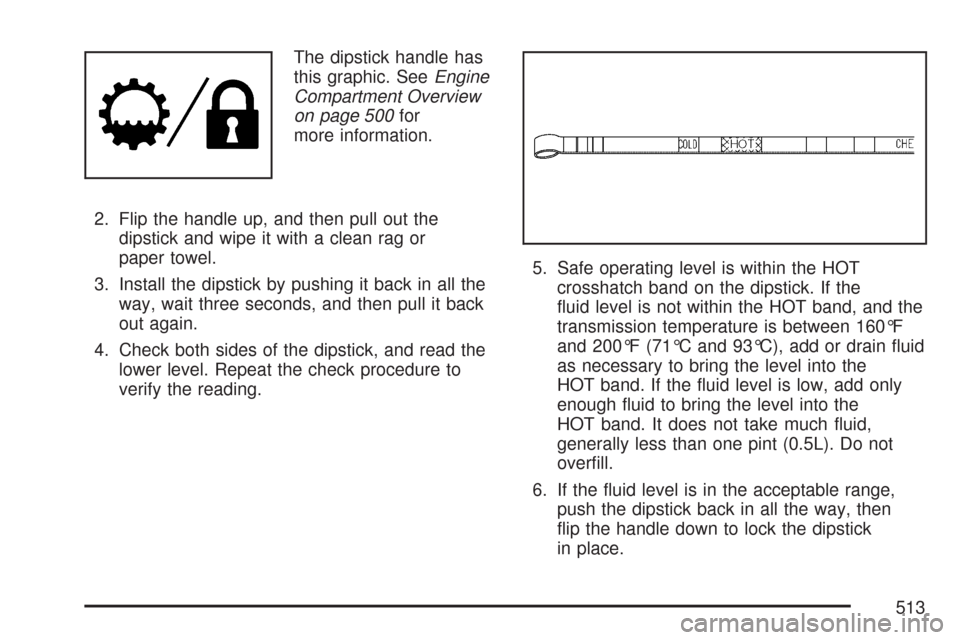Page 495 of 684
The tethered fuel cap is located behind a hinged
fuel door on the driver’s side of the vehicle. If
the vehicle has E85 fuel capability, a yellow cap
with the words “E85 / Gasoline” can be seen.
To remove the fuel cap, turn it slowly
counterclockwise.
{CAUTION:
Fuel can spray out on you if you open the
fuel cap too quickly. If you spill fuel and
then something ignites it, you could be
badly burned. This spray can happen if
your tank is nearly full, and is more likely
in hot weather. Open the fuel cap slowly
and wait for any hiss noise to stop. Then
unscrew the cap all the way.
If your vehicle is a dual fuel tank chassis cab
model, and it runs out of fuel, refuel the front fuel
tank �rst to ensure a quick restart.
Be careful not to spill fuel. Do not top off or over�ll
the tank and wait a few seconds after you have
�nished pumping before removing the nozzle.
Clean fuel from painted surfaces as soon
as possible. SeeWashing Your Vehicle on
page 605.
495
Page 496 of 684

When replacing the fuel cap, turn it clockwise until
it clicks. It will require more effort to turn the
fuel cap on the last turn as you tighten it. Make
sure the cap is fully installed. The diagnostic
system can determine if the fuel cap has been left
off or improperly installed. This would allow fuel
to evaporate into the atmosphere. SeeMalfunction
Indicator Lamp on page 262.
The TIGHTEN GAS CAP message will be
displayed on the Driver Information Center (DIC) if
the fuel cap is not properly installed. SeeDIC
Warnings and Messages on page 281for more
information.
{CAUTION:
If a �re starts while you are refueling, do
not remove the nozzle. Shut off the �ow of
fuel by shutting off the pump or by
notifying the station attendant. Leave the
area immediately.Notice:If you need a new fuel cap, be sure to
get the right type. Your dealer/retailer can
get one for you. If you get the wrong type, it
may not �t properly. This may cause your
malfunction indicator lamp to light and may
damage your fuel tank and emissions system.
SeeMalfunction Indicator Lamp on page 262.
496
Page 501 of 684

A. Engine Air Cleaner/Filter. SeeEngine Air
Cleaner/Filter (Gasoline Engines) on page 507.
B. Air Filter Restriction Indicator (If Equipped).
SeeEngine Air Cleaner/Filter (Gasoline
Engines) on page 507.
C. Coolant Surge Tank and Pressure Cap. See
Cooling System on page 521andCoolant
Surge Tank Pressure Cap on page 517.
D. Positive (+) Terminal. SeeJump Starting on
page 534.
E. Battery. SeeBattery on page 533.
F. Engine Oil Fill Cap. See “When to Add Engine
Oil” underEngine Oil (Gasoline Engine) on
page 502.
G. Automatic Transmission Dipstick. See
“Checking the Fluid Level” underAutomatic
Transmission Fluid on page 510.H. Remote Negative (−) Terminal (Out of View).
SeeJump Starting on page 534.
I. Engine Oil Dipstick (Out of View). See
“Checking Engine Oil” underEngine Oil
(Gasoline Engine) on page 502.
J. Engine Cooling Fan. SeeCooling System on
page 521.
K. Power Steering Fluid Reservoir. SeePower
Steering Fluid on page 526.
L. Brake Master Cylinder Reservoir. See “Brake
Fluid” underBrakes on page 529.
M. Underhood Fuse Block. SeeUnderhood Fuse
Block on page 615.
N. Windshield Washer Fluid Reservoir. See
“Adding Washer Fluid” underWindshield
Washer Fluid on page 527.
501
Page 512 of 684

3. Install the dipstick by pushing it back in all the
way, wait three seconds, and then pull it back
out again.
4. Check both sides of the dipstick, and read the
lower level. Repeat the check procedure to
verify the reading.
5. If the �uid level is below the COLD check
band, add only enough �uid as necessary
to bring the level into the COLD band. It does
not take much �uid, generally less than
one pint (0.5L). Do not over�ll.6. Perform a hot check at the �rst opportunity
after the transmission reaches a normal
operating temperature between 160°F to
200°F (71°C to 93°C).
7. If the �uid level is in the acceptable range,
push the dipstick back in all the way, then
�ip the handle down to lock the dipstick
in place.
Hot Check Procedure
Use this procedure to check the transmission �uid
level when the transmission �uid temperature is
between 160°F and 200°F (71°C and 93°C).
The hot check is the most accurate method to
check the �uid level. The hot check should be
performed at the �rst opportunity in order to verify
the cold check. The �uid level rises as �uid
temperature increases, so it is important to ensure
the transmission temperature is within range.
1. Locate the transmission dipstick at the rear of
the engine compartment, on the passenger’s
side of the vehicle.
512
Page 513 of 684

The dipstick handle has
this graphic. SeeEngine
Compartment Overview
on page 500for
more information.
2. Flip the handle up, and then pull out the
dipstick and wipe it with a clean rag or
paper towel.
3. Install the dipstick by pushing it back in all the
way, wait three seconds, and then pull it back
out again.
4. Check both sides of the dipstick, and read the
lower level. Repeat the check procedure to
verify the reading.5. Safe operating level is within the HOT
crosshatch band on the dipstick. If the
�uid level is not within the HOT band, and the
transmission temperature is between 160°F
and 200°F (71°C and 93°C), add or drain �uid
as necessary to bring the level into the
HOT band. If the �uid level is low, add only
enough �uid to bring the level into the
HOT band. It does not take much �uid,
generally less than one pint (0.5L). Do not
over�ll.
6. If the �uid level is in the acceptable range,
push the dipstick back in all the way, then
�ip the handle down to lock the dipstick
in place.
513
Page 524 of 684

{CAUTION:
Adding only plain water to your cooling
system can be dangerous. Plain water, or
some other liquid such as alcohol, can
boil before the proper coolant mixture will.
Your vehicle’s coolant warning system is
set for the proper coolant mixture. With
plain water or the wrong mixture, your
engine could get too hot but you would
not get the overheat warning. Your engine
could catch �re and you or others could
be burned. Use a 50/50 mixture of clean,
drinkable water and a proper coolant.
Notice:In cold weather, water can freeze and
crack the engine, radiator, heater core and
other parts. Use the recommended coolant and
the proper coolant mixture.
{CAUTION:
You can be burned if you spill coolant on
hot engine parts. Coolant contains
ethylene glycol and it will burn if the
engine parts are hot enough. Do not spill
coolant on a hot engine.
1. Remove the coolant
surge tank pressure
cap when the
cooling system,
including the coolant
surge tank
pressure cap and
upper radiator hose,
is no longer hot.
Turn the pressure cap slowly counterclockwise
about one full turn. If you hear a hiss, wait
for that to stop. A hiss means there is
still some pressure left.
524
Page 546 of 684
Headlamps
To replace one of these bulbs, do the following:
1. Open the hood. SeeHood Release on
page 498for more information.
2. If you are replacing the bulb on the passenger
side remove the Engine Air Cleaner cover.
SeeEngine Air Cleaner/Filter (Gasoline
Engines) on page 507for more information.
3. Reach in and access the bulb sockets from
inside the engine compartment.4. Turn the bulb socket counterclockwise to
remove it from the headlamp assembly
and pull it straight out.
5. Unplug the electrical connector from the old
bulb by releasing the clips on the bulb
socket.
6. Replace it with a new bulb socket.
7. Plug in the electrical connector to the new
bulb socket.
8. Reinstall the new bulb socket into the
headlamp assembly and turn it clockwise to
secure.
9. Close the hood.
546
Page 547 of 684
Center High-Mounted Stoplamp
(CHMSL) and Cargo Lamp
To replace one of these bulbs, do the following:
1. Remove the screws and lift off the lamp
assembly.A. Cargo Lamp
B. Center High-Mounted Stoplamp Bulb
2. Remove the CHMSL and Cargo bulbs by
turning socket counterclockwise and pulling
the bulb straight out.
3. Install the CHMSL and Cargo bulbs by
pushing the bulb straight in and turning
clockwise.
4. Reinstall the lamp assembly and tighten the
screws.
547